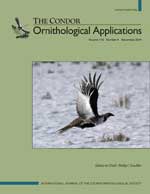Degradation of nesting habitat for coastal birds has led to the use of nontraditional nesting habitat. The American Oystercatcher (Haematopus palliatus) is listed as a “Species of High Concern” by the U.S. Shorebird Conservation Plan and is declining in the southern portion of its U.S. breeding range, where ∼50% of breeding oystercatchers nest on shell substrate instead of beachfront habitat. We measured daily survival rates during incubation and chick rearing in shell rake habitats over five breeding seasons in the Cape Romain region of South Carolina, USA. Of 354 nesting attempts monitored, 16.1% hatched at least one egg. During incubation, daily survival rate was 0.938, corresponding to 22.8% success to hatching (nest success). For broods, daily survival was 0.991, or 74.0% success from hatching to fledging. Productivity in the Cape Romain region is primarily being lost during the incubation phase, when nests are exposed to overwash and predation. Mobile chicks may, however, be able to avoid flood events or predators by relocating to higher or more protected portions of a shell rake. Based on comparative data for American Oystercatchers from elsewhere in their range, it does not appear that shell rakes in the Cape Romain region are inferior breeding habitat. Our data suggest that conservation actions targeting nest and chick loss from flooding and predation have the greatest opportunity to enhance reproductive success in this core breeding area, and that an assessment of the availability, structure, avian use, and protection status of shell rakes is warranted.
BioOne.org will be down briefly for maintenance on 17 December 2024 between 18:00-22:00 Pacific Time US. We apologize for any inconvenience.
How to translate text using browser tools
29 October 2014
Reproductive ecology of American Oystercatchers nesting on shell rakes
Patrick G. R. Jodice,
Janet M. Thibault,
Samantha A. Collins,
Mark D. Spinks,
Felicia J. Sanders
ACCESS THE FULL ARTICLE

The Condor
Vol. 116 • No. 4
November 2014
Vol. 116 • No. 4
November 2014
American Oystercatcher
Cape Romain
daily survival rate
flooding
Haematopus palliatus
predation
reproductive success




